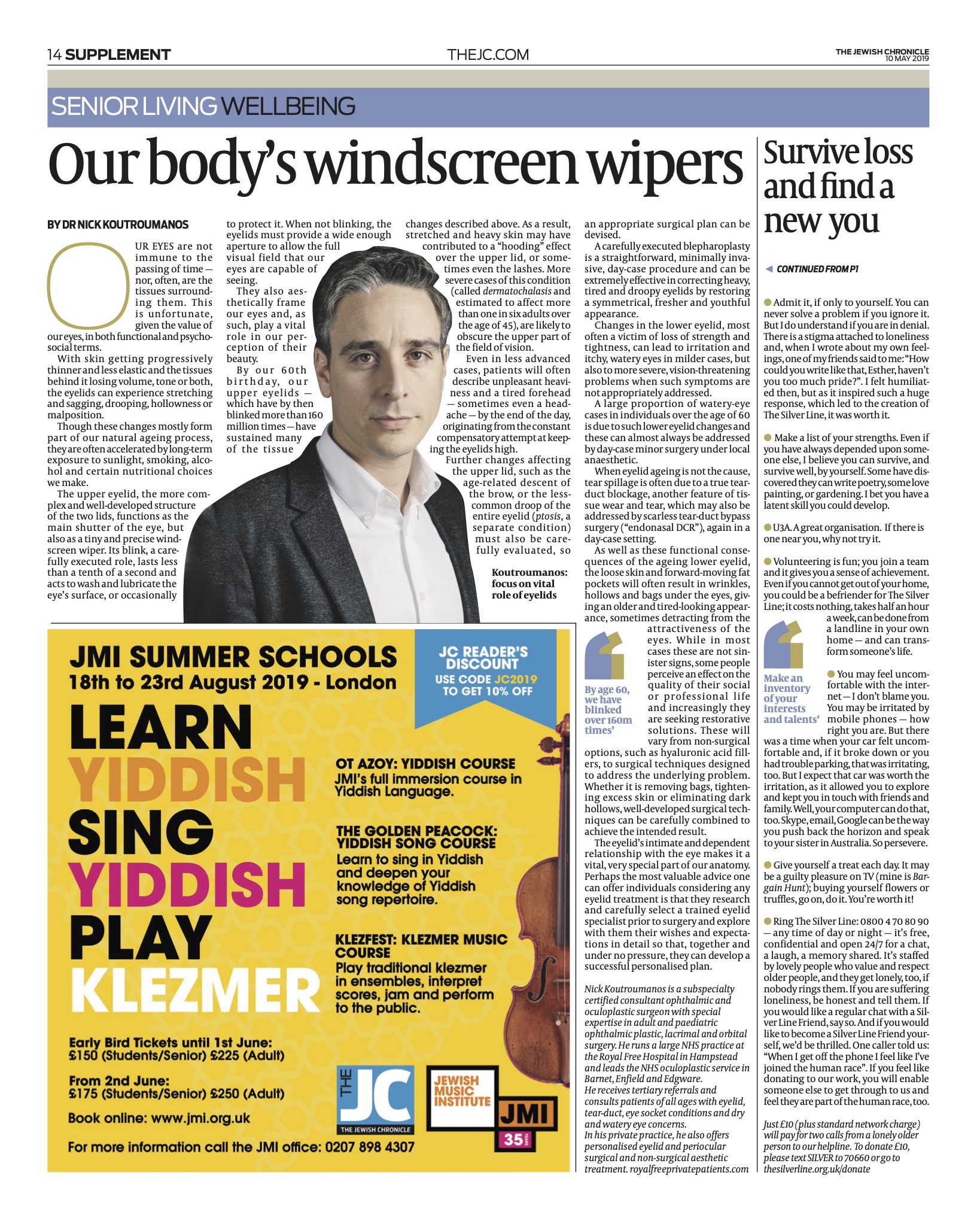Tired, aged, droopy eyes? This article by London oculoplastic surgeon Dr Koutroumanos, explains the science behind it and what can safely be done for healthier and fresher eyes.
Our eyes are not immune to the passing of time — nor, often, are the Periocular connective tissues supporting them. Involutional changes to the eyelids can result in significant acute or chronic visual symptoms as well as ocular discomfort or pain. There is also often a significant psychosocial impact as well as an effect on some patients’ career.
The eyelid skin is the thinnest in the body. As it gets progressively thinner and less elastic and the orbital tissues behind it losing volume, tone or both, the eyelids can experience stretching and sagging, drooping, hollowness or malposition.
Though these changes mostly form part of the natural aging process, they are often accelerated by long-term exposure to sunlight, smoking, alcohol and certain nutritional choices that patients make.
The upper eyelid, the more complex and well-developed structure of the two lids, functions as the main shutter of the eye, but also as a tiny and precise windscreen wiper. Its blink, a carefully executed role, lasts less than a tenth of a second and acts to wash and lubricate the corneal surface, or occasionally to protect it. When not blinking, the eyelids must provide a wide enough aperture to allow the full visual field that our eyes are capable of seeing. They also aesthetically frame our eyes and as such play a vital role in our perception of their beauty.
By our 60th birthday, our upper eyelids — which have by then blinked more than 160 million times — have sustained many of the tissue changes described above.
As a result, stretched and heavy skin may have contributed to a “hooding” effect over the upper lid, or sometimes even the lashes. More severe cases of this condition (called dermatochalasis and estimated to affect more than one in six adults over the age of 45), are likely to obscure the upper part of the field of vision. Even in less advanced cases, patients will often describe unpleasant heaviness and a tired forehead – sometimes even a headache – by the end of the day, originating from the constant compensatory attempt at keeping the eyelids high.
Further changes affecting the upper lid, such as the age-related descent of the brow or the less-common “droop” of the entire eyelid (ptosis, a separate condition) must also be carefully evaluated, so an appropriate surgical plan can be devised.
A carefully executed blepharoplasty is a straightforward, minimally invasive, day-case procedure and can be extremely effective in correcting heavy, tired and droopy eyelids by restoring a symmetrical, fresher and youthful appearance.
Changes in the lower eyelid, most often a victim of loss of strength and tightness, can lead to irritation and itchy, watery eyes in milder cases, but also to more severe, vision-threatening problems when such symptoms are not appropriately addressed. A large proportion of watery eye cases in individuals over the age of 60 is due to such lower eyelid changes and these can almost always be addressed by day-case minor surgery under local anaesthetic.
When eyelid aging is not the cause, tear spillage is often due to a true nasolacrimal duct obstruction, another feature of tissue wear-and-tear, which may also be addressed by scarless tear-duct bypass surgery (endonasal dacryocystorhinostomy), again in a day-case setting.
Further to these functional consequences of the aging lower eyelid, the loose skin and forward-moving fat pockets will often result in wrinkles, hollows and bags under the eyes, giving an older and tired-looking appearance, sometimes detracting from the attractiveness of the eyes. While in most cases these are not sinister signs, increasingly more individuals are appreciating an effect on the quality of their social or professional life and are seeking restorative solutions. These will vary from non-surgical options such as hyaluronic acid fillers, to surgical techniques designed to address the underlying problem. Whether it is removing bags, tightening excess skin or eliminating dark hollows, well-developed surgical techniques can be carefully combined to achieve the intended result.
The eyelid’s intimate and dependent relationship with the corneal surface makes it a vital and very special part of our body’s anatomy. Perhaps the most valuable advice one can offer individuals considering any eyelid treatment is that they research and carefully select a specially trained eyelid specialist prior to undergoing surgery and that they explore with them their wishes and expectations in detail so that they can together and under no pressure develop a successful personalised plan.







